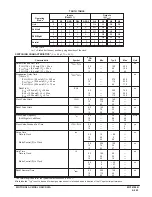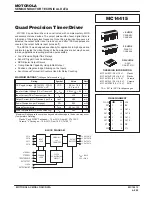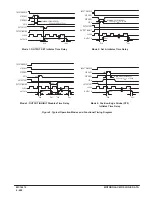
MOTOROLA CMOS LOGIC DATA
6–213
MC14490
THEORY OF OPERATION
The MC14490 Hex Contact Bounce Eliminator is basically
a digital integrator. The circuit can integrate both up and
down. This enables the circuit to eliminate bounce on both
the leading and trailing edges of the signal, shown in the tim-
ing diagram of Figure 3.
Each of the six Bounce Eliminators is composed of a
4–1/2–bit register (the integrator) and logic to compare the
input with the contents of the shift register, as shown in Fig-
ure 4. The shift register requires a series of timing pulses in
order to shift the input signal into each shift register location.
These timing pulses (the clock signal) are represented in the
upper waveform of Figure 3. Each of the six Bounce Elimi-
nator circuits has an internal resistor as shown in Figure 4. A
pullup resistor was incorporated rather than a pulldown resis-
tor in order to implement switched ground input signals, such
as those coming from relay contacts and push buttons. By
switching ground, rather than a power supply lead, system
faults (such as shorts to ground on the signal input leads) will
not cause excessive currents in the wiring and contacts. Sig-
nal lead shorts to ground are much more probable than
shorts to a power supply lead.
When the relay contact is closed, (see Figure 4) the low
level is inverted, and the shift register is loaded with a high on
each positive edge of the clock signal. To understand the op-
eration, we assume all bits of the shift register are loaded
with lows and the output is at a high level.
At clock edge 1 (Figure 3) the input has gone low and a
high has been loaded into the first bit or storage location of
the shift register. Just after the positive edge of clock 1, the
input signal has bounced back to a high. This causes the
shift register to be reset to lows in all four bits — thus starting
the timing sequence over again.
During clock edges 3 to 6 the input signal has stayed low.
Thus, a high has been shifted into all four shift register bits
and, as shown, the output goes low during the positive edge
of clock pulse 6.
It should be noted that there is a 3–1/2 to 4–1/2 clock peri-
od delay between the clean input signal and output signal. In
this example there is a delay of 3.8 clock periods from the
beginning of the clean input signal.
After some time period of N clock periods, the contact is
opened and at N + 1 a low is loaded into the first bit. Just after
N + 1, when the input bounces low, all bits are set to a high. At
N + 2 nothing happens because the input and output are low
and all bits of the shift register are high. At time N + 3 and
thereafter the input signal is a high, clean signal. At the posi-
tive edge of N + 6 the output goes high as a result of four lows
being shifted into the shift register.
Assuming the input signal is long enough to be clocked
through the Bounce Eliminator, the output signal will be no
longer or shorter than the clean input signal plus or minus
one clock period.
The amount of time distortion between the input and output
signals is a function of the difference in bounce characteris-
tics on the edges of the input signal and the clock frequency.
Since most relay contacts have more bounce when making
as compared to breaking, the overall delay, counting bounce
period, will be greater on the leading edge of the input signal
than on the trailing edge. Thus, the output signal will be
shorter than the input signal — if the leading edge bounce is
included in the overall timing calculation.
The only requirement on the clock frequency in order to
obtain a bounce free output signal is that four clock periods
do not occur while the input signal is in a false state. Refer-
ring to Figure 3, a false state is seen to occur three times at
the beginning of the input signal. The input signal goes low
three times before it finally settles down to a valid low state.
The first three low pulses are referred to as false states.
If the user has an available clock signal of the proper fre-
quency, it may be used by connecting it to the oscillator input
(pin 7). However, if an external clock is not available the user
can place a small capacitor across the oscillator input and
output pins in order to start up an internal clock source (as
shown in Figure 4). The clock signal at the oscillator output
pin may then be used to clock other MC14490 Bounce Elimi-
nator packages. With the use of the MC14490, a large num-
ber of signals can be cleaned up, with the requirement of
only one small capacitor external to the Hex Bounce Elimina-
tor packages.
Figure 3. Timing Diagram
OSCin OR OSCout
INPUT
OUTPUT
CONTACT
OPEN
CONTACT
BOUNCING
CONTACT CLOSED
(VALID TRUE SIGNAL)
CONTACT
BOUNCING
CONTACT OPEN
N + 7
N + 5
N + 3
N + 1
6
5
4
3
2
1
Summary of Contents for CMOS Logic
Page 1: ......
Page 5: ...iv MOTOROLA CMOS LOGIC DATA ...
Page 6: ...Master Index 1 ...
Page 12: ...Product Selection Guide 2 ...
Page 17: ...The Better Program 3 ...
Page 20: ...B and UB Series Family Data 4 ...
Page 25: ...CMOS Handling and Design Guidelines 5 ...
Page 32: ...CMOS Handling and Design Guidelines 5 ...
Page 39: ...Data Sheets 6 ...
Page 234: ...MOTOROLA CMOS LOGIC DATA MC14174B 6 196 FUNCTIONAL BLOCK DIAGRAM TIMING DIAGRAM ...
Page 238: ...MOTOROLA CMOS LOGIC DATA MC14175B 6 200 FUNCTIONAL BLOCK DIAGRAM TIMING DIAGRAM ...
Page 555: ...CMOS Reliability 7 ...
Page 561: ...Equivalent Gate Count 8 ...
Page 563: ...Packaging Information Including Surface Mounts 9 ...
Page 571: ......
















































